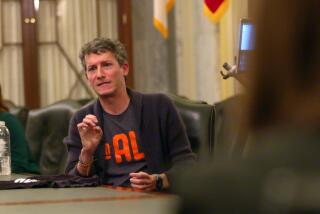Breaking Their Silence : Palmdale Software Creator Has Given Stephen Hawking and Others Like Him the Means to Communicate
- Share via
PALMDALE — Software creator Walter Woltosz got a mysterious phone call from Cambridge University in 1985, shortly after he started selling a computer system he had designed to allow severely disabled people to write and even “speak” by manipulating a single button.
News of the system had reached the caller, who wondered if it might be right for “a very bright fellow” at the English university who had amyotrophic lateral sclerosis, better known as Lou Gehrig’s disease.
The caller would not tell Woltosz who the bright fellow was.
But Woltosz thought he knew.
“I said to him, ‘If it’s Stephen Hawking, I’ll donate whatever he needs,’ ” recalled Woltosz, sitting in his Palmdale office off a dusty road in the high desert.
Back then, Hawking, now a celebrity scientist, was not well known outside scientific circles. But Woltosz, an engineer with a love of physics, had long been a fan of the wheelchair-bound scientist.
The caller thanked him politely and hung up. A few minutes later, he called back to say, “Stephen Hawking would like to try your system.”
It was a pivotal moment in the lives of both Hawking and Woltosz. The celebrated physicist, who had been diagnosed with ALS in 1963, had just had his vocal cords removed in order to help him breathe.
His speech, badly slurred for several years, was now gone. And he no longer had the strength to use a pen or type.
Suddenly, one of science’s greatest minds was isolated from the world.
Although not nearly in such dire straits, Woltosz and his wife had left their secure jobs to devote all their time and resources to the computer system Woltosz had invented. At the time of the call, Woltosz, formerly an aerospace engineer, was working without salary to help keep the company going.
Hawking quickly took to the system, using it to return to his life of lecturing and conferring with colleagues.
“Without this software or something like it,” Hawking said in a recent interview, conducted via e-mail, “I would have been cut off and unable to carry on as a physicist.”
He also used the software to write his hugely successful book, “A Brief History of Time” (1988), which led to appearances on television and in films, making his digitized voice famous all over the world.
In the book’s acknowledgments, he paid tribute to Woltosz’s work. “With this system,” he wrote, “I can communicate better now than before I lost my voice.”
That statement helped build Woltosz’s company from a two-room operation to a multimillion-dollar enterprise.
*
“He has done so much in publicity for us over the years,” said Woltosz, now 52, of Hawking. “Here was a person who was working on such a phenomenally high level and had so much to offer the world. That we were able to take part in enabling him to work gave us a badge of credibility.”
There are now at least a half-dozen firms producing computer speech and writing systems for the disabled. These systems are especially vital to people with ALS, about 75% of whom lose the ability to speak.
“It has made a dramatic change in how these people live,” said David Beukelman, a professor at the University of Nebraska and leading researcher in the field called augmentative and alternative communication, or AAC.
“The technology came about just at the time when society started to look differently upon disabled people. Before the ‘60s and ‘70s, they were considered people to be cared for and shielded from the world.
“The changing attitudes, plus the technology, have made a huge difference in how disabled people are included in society.”
Woltosz learned firsthand the frustrations of a person with ALS, whose mind remains sharp while his or her body breaks down. In 1978 his mother-in-law, Lucy Evans, came down with ALS and within two years she could no longer speak or write.
“She had been a strong communicator,” Woltosz said, “very outspoken. It was very hard for her to be without words.”
He told a story about her husband coming home one day to find she was obviously troubled. She was looking toward a bookcase near the door.
Her husband began pointing to different books and objects, trying to figure out what she wanted, but nothing seemed to calm her. It is a common situation for people with ALS.
“The person trying to communicate had to play a kind of guessing game,” said Beukelman.
Woltosz’s father-in-law tried for 45 minutes to figure out what his wife was trying to convey.
“She was in tears, and he was so frustrated,” said Woltosz. “Just then a neighbor came up to the house and said to him, ‘Hey, did you realize you left your keys in the door?’ ”
Woltosz was then working as an engineer and manager at United Technologies in Sunnyvale, near San Jose. In his spare time, he tinkered with an early home computer, trying to work out a way Evans could communicate with the use of a single push-button switch she could operate with the bit of strength left in her fingers.
Woltosz and his wife, Ginger, devised a series of number codes corresponding to phrases Evans might want to use. For example, 913 was “I’m cold,” 314 was “reading glasses” and 908 meant “I want to sit up.” The idea was that Evans could use the switch to make the digits appear on the computer screen.
The main problem was with the switch. “I went to the hardware store and got a doorbell to use as the push button,” Woltosz said. “But we take for granted how much strength it takes to push it. I needed something for someone who could barely move her finger.”
Evans died before he could perfect the system, but he pressed on, working with other local disabled people. He eventually developed a switch with an appropriately light touch and, instead of a number-based system, he put common phrases on the computer screen. Users would press the switch to stop a moving cursor on the phrase they wanted.
Meanwhile, Beukelman and others in the AAC field were doing research into what phrases and words were most often used in everyday conversation. “We would put portable tape recorders on natural speakers and record everything they would say in a week,” Beukelman said, noting that the research volunteers had the option of turning off the recorder during especially private conversations.
He and his colleagues found that, among adult subjects, age was a major factor in determining how conversations would go. “For people in their 20s and 30s, nearly 40% of utterances were what we call generic small talk,” Beukelman said. “Phrases like ‘How’s it going?’ ‘How are you doing?’ ‘What’s happening?’ are used to connect with people, but we don’t expect a real answer.”
As people grow older, the use of generic small talk falls off sharply. “Older people tend to make fewer new contacts in their daily lives,” Beukelman said. “And they tend to tell stories from their past to connect with others.”
AAC software developers used the published research to help determine what phrases would be included in their software. In the latest version released by Woltosz’s company, Words Plus, the phrases are divided into categories for faster access. Under “commentary,” for example, are “This is fun” and “This is fantastic.”
Other categories include “responses,” “manners” and even “insults,” from which one can choose, “What a slob” or “If brains were gunpowder, you wouldn’t have enough to blow your nose.”
*
The vice president of operations for Words Plus, Phil Lawrence, said the company strives to keep the built-in phrases up to date for young users, which is why “Don’t have a cow, man” is now included.
“We have to allow our users to be as naughty as any able-bodied student,” he said.
Users can employ the software to add their own oft-used phrases to the lists. And for conversations that go beyond catch phrases, they can put together sentences, word by word, from a vocabulary of about 5,000 words.
They can also use letters to spell out words not in the database, but that takes more time.
The phrases, words and letters are on pages that flip by quickly on the computer screen. The user touches the switch to stop on the appropriate page, then again to choose a line of items, and then once more to pick a specific item. A whole speech can be written, stored and then, with one touch, delivered.
A highly skilled user like Hawking can use the software to speak about 20 words per minute in conversations, in comparison with an average of 150 to 200 for natural speakers.
Woltosz moved his company to Palmdale in 1991 so he could be closer to his children from an earlier marriage, and also to take advantage of the area’s lower housing and office-space costs.
Word Plus is not the biggest company in the computerized AAC field. Its main selling point for its products is that its software runs on off-the-shelf computers. Therefore, the users can also use a Words Plus-equipped computer (which currently sells for about $6,000, including voice generator) to run financial software, play games and control their environment--turn on lights, change TV channels, etc.
“I don’t know other software that will allow someone like me to communicate and use a wide range of programs and the Internet,” Hawking commented.
With the help of a National Science Foundation grant last year, Woltosz began to develop computerized science learning programs specifically for the disabled. He hopes to take what he learned and make similar programs--such as those showing chemical experiments--available to able-bodied students.
Other companies are also developing those kinds of programs. But the one thing Words Plus has going for it that others in the field can’t claim is the Hawking connection.
Last year, Woltosz invited the physicist to visit Palmdale while Hawking was in residence at Caltech. Hawking took him up on it, and Woltosz thought that, while there, a tour of the Northrop Grumman plant where the B-2 Stealth bomber is assembled might be of interest.
Woltosz’s daughter, who works at Northrop, asked company officials if a tour could be arranged. “They said that only one foreign national had ever been allowed inside the plant to get close to the B-2, and that was Margaret Thatcher,” said Woltosz.
But it seems Hawking ranks at least as high as a head of state.
“They said he could be the second.”







